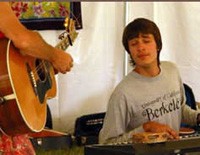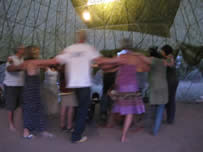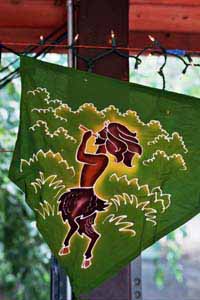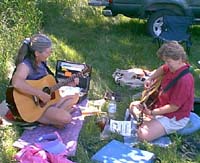Advanced Chords and Music Theory for Open Tuning
by Nur al-Haqq Dave Walker
last revised 7/08
While the concepts described on this page apply to any key, the chord pattern table below is a relative to the key of C (ie, capo 5th fret on G open). This means that you'll have to move the capo and transpose the chord lettering for songs in other keys. Because there are always extra "bass notes" (in this case Cs and sometimes Gs) to give that delightful, middle eastern/eastern drone sound, you will need to transpose for other keys. Trust me, playing a Dm song (or even an Am song) from the C position sounds wretched! I hope in the future to create a chart that will do the transposing for you, but for now this will get you started. Reading from left to right, the number patterns correspond to which fret to finger from low C to high G. An "x" means don't play that string and an "o" means play the string open. The (-3), etc next to the chords indicates a note (eg the third) is missing from the full chord, but for the most part, the feeling of the whole chord comes through - much like the case in modern jazz. In this case, the overall sound depends a lot on what chord you are coming from and what chord you are going to. It's not a foolproof system. You'll have to play with it on a song by song basis. (Note: the minor chords without the third don't work well in any case.) The clear rule to follow is this: if it doesn't sound good, don't play it! ...Enjoy!
Chord Pattern
| C |
o4oo4o |
| C |
oo54oo |
| C6 |
oo24oo |
| C7 |
oo34oo |
| Cmaj7 |
oo44oo |
| Cm |
o3oo3o |
| Cm |
oo53oo |
| Cm6 |
oo23oo |
| Cm7 |
oo33oo |
| C#/Db |
111151 |
| C#7/ Db7 |
111154 |
| C#(-3)/Db(-3) |
111111 |
| C#m/Dbm |
111141 |
| C#m(-3)/Dbm(-3) |
111111 |
| C#m7/Dbm7 |
111144 |
| D |
222262 |
| D(-3) |
222222 |
| D7(-3) |
oo22oo |
| Dm |
222252 |
| Dm(-3) |
222222 |
| Dm7(-3) |
oo22oo |
| D#(-3)/Eb(-3) |
oo3333 |
| D#7(-3)/Eb7(-3) |
oo3133 |
| D#m(-3)/Ebm(-3) |
oo3333 |
| D#m7(-3)/Ebm7(-3) |
oo3133 |
| E(-3) |
oo4444 |
| E7(-3) |
oo4244 |
| Em |
oo44oo |
| Em7 |
oo424o |
| F |
oo25ox |
| F6(-1) |
oo22oo |
| F7 |
oo235x |
| F7(-1) |
oo23ox |
| Fm |
oo15ox |
| Fm6 |
oo125x |
| Fm6(-1) |
oo12ox |
| Fm7 |
oo135x |
| Fm7(-1) |
oo13ox |
| F#(-3)/Gb(-3) |
oo6666 |
| F#7(-3)/Gb7(-3) |
oo6466 |
| F#m(-3)/Gbm(-3) |
oo6666 |
| F#m7(-3)/Gbm7(-3) |
oo6466 |
| G |
ooo224 |
| G |
oo42oo |
| G6 |
oo424o |
| G7 |
oo425o |
| G7(-5) |
ooo554 |
| Gm |
oo32oo |
| Gm |
ooo223 |
| Gm7 |
oo325o |
| Gm7(-5) |
o535oo |
| G#/Ab |
oo13ox |
| G#7(-1)/Ab7(-1) |
oo536x |
| G#m7(-1)/Abm7(-1) |
oo436x |
| G#maj7/Abmaj7 |
oo13oo |
| A |
xx214x |
| A7 |
xx214o |
| Adim |
oo23ox |
| Am |
oo24ox |
| Am7 |
oo24oo |
| A#/Bb |
oo325x |
| A#(-3)/Bb(-3) |
o535ox |
| A#6/Bb6 |
oo325o |
| A#7(-5)/Bb7(-5) |
xx3221 |
| A#m/Bbm |
xx315x |
| A#m7(-5)/Bbm7(-5) |
xx3111 |
| B |
xx436x |
| B7 |
xx4362 |
| Bdim |
oo425x |
| Bm |
xx426x |
| Bm7 |
xx4262 |
Open Tuning Theory
(Dave Nur-al-Haqq, Lama, 2002)
Play melody line on 3rd and 5th strings/1st and 4th strings.
Chords: Find the melody on the third string; there will be a complimentary note on the 4th string, either next fret up or 2 up (see chord diagrams). If the melody is on the top string, then the complimentary note is probably one or two frets down on the 2nd string.
As the guitar player,if you can find the melody using one finger/string, then as the Dance progresses you can add the other note of the chord as you find it.
Major Key
Root chord: on the 3rd and 4th strings, 4th and 5th frets up from the capo, respectively.
IV: 4th string, 2nd fret; 3rd string, 5th fret.
V: 4th string, 4th fret; 3rd string, 2nd fret.
You can walk through a whole scale (octave) using these three chords.
Minor Key
Root chord: 3rd string, 3rd fret; 4th string, 5th fret. (This is flattening the third from the same major, eg C to Cm.)
IV: 4th string, 1st fret; 3rd string, 5th fret.
V: 3rd string, 2nd fret; 4th string, 3rd fret. (Since V chord in a minor key is not always flat, you may not need this.)
Relative minors
(Eg, in C, Am, Em, Dm)
Root: 4th string, 2nd fret; 3rd string, 4th fret.
IV: Bar on 4th fret; 2nd or 3rd string, 7th fret.
V: Bar on 2nd fret; 2nd or 3rd string, 5th fret.
Note: In regular music theory, a song in Am is really in C, but in this theory you’d capo on the 2nd fret to be in A, not the 5th fret to be in C.
V Chord with 7: Add 2nd string, 5th fret.
II chord: Bar 2nd fret, add 2nd string, 6th fret (ref relative minor of IV).
|













